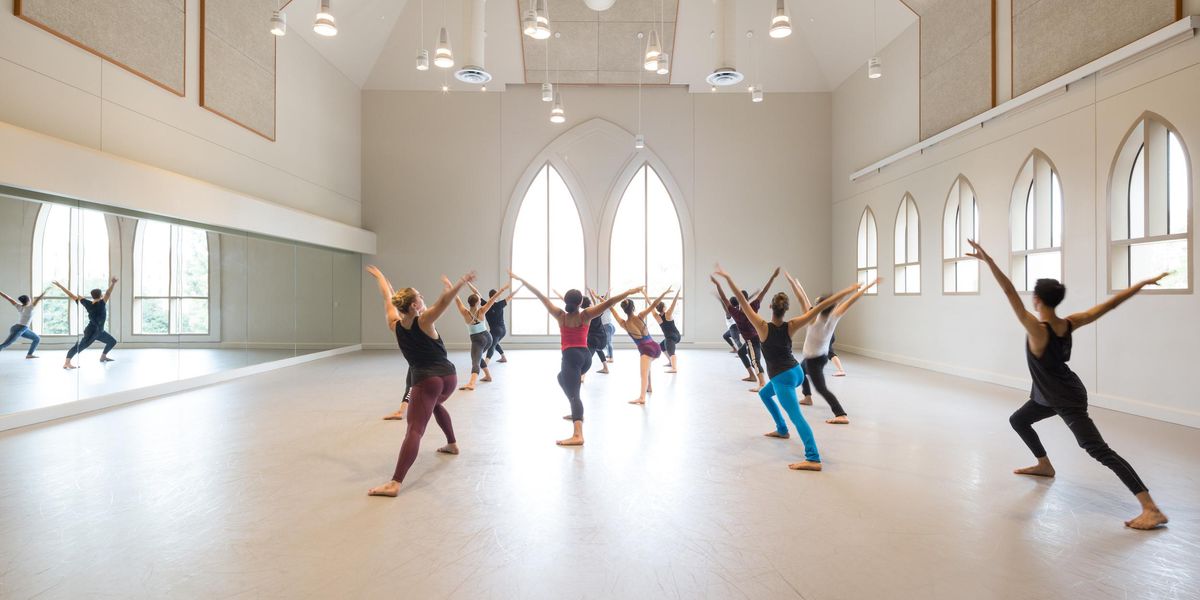2013 Summer Study Guide: Creativity Grows in "The Swamp"
A Florida summer intensive sends dancers exploring.
West African class at the Swamp Dance Fest, 2012. Photo: Carrie Seidman, Courtesy Seidman.
Indian music swells to a crescendo as dancers twirl, writhe, and lunge. A gentle young man is calling out suggestions based on images drawn from nature and nurture. There are no mirrors to reflect and inhibit, no observers to provoke self-consciousness or preening. There is only the music, the movement, and a lot of internal focus.
This scene is not taking place in some faraway land, but rather in a large, light-filled studio on the campus of the University of Florida, during a Gaga class that is part of the Swamp Dance Fest, a summer intensive workshop quite unlike any other.
The month-long program for professionals and pre-professionals 16 and older offers classes not only in Gaga (created by the Batsheva Dance Company’s renowned artistic director, Ohad Naharin), but also West African and contemporary dance among other genres, as well as opportunities to experiment and innovate with an unusual degree of freedom.
“Everything is grown in ‘The Swamp,’ ” says founder Neta Pulvermacher, a UF School of Theater and Dance professor and the director of the New York City–based Neta Dance Company, referring to the nickname for the moist and verdant Gainesville campus that gives the workshop its moniker. “It’s a true lab. The product is important, but just as important is the space to explore and the possibility to fail. Experience is what we’re looking for, but not in the usual sense—rather, an experience.”
Pulvermacher, a native of Israel, first directed the program in 2009. Prompted by her global outlook and belief that “no one owns a culture or knowledge,” she began inviting international artists—including Gaga teacher Yaniv Abraham, a former Batsheva dancer, and Mohamed Dacosta of Guinea—to participate. In 2012, choreographer and performance artist artist Richard Move and a handful of dancers from Chad were added to the eclectic mix. Together with 70-plus students, they produced an original work, with each successive evolution given a public showing on Friday afternoons.
“The idea is for us to feel free, fresh, and challenged to create without constraints, but also to really challenge the notion of what people think dance is, or could be,” says Pulvermacher.
The experience represented a new degree of professionalism and personal power for Sarah Nelson, 20, a UF junior dance major. “We’re not treated as just students, we’re treated as fellow artists,” says Nelson. “It’s interesting because everyone has a different perspective and you can learn something from everyone. There’s something beautiful about every opinion and every body.”
With the addition of the Gaga classes the past two summers, recent UF graduate Whitney Wilson, 23, found the Swamp Fest experience to be “transformative,” particularly given her competition dance background. “So much of it is in the moment, making choices,” Wilson says of the Gaga experience. “I can feel my patterns breaking. There are beautiful metaphors connecting effort to pleasure instead of focusing on the difficulty. I had basically trained the humanity out of my body.”
Pulvermacher says she’s “never seen any conflict between laughing hard and working hard.” So, a lot of both takes place during Swamp Fest—not to mention a little singing (the Chadians taught everyone a simple melody in French that was incorporated into the final performance), filming (Move shot Abraham teaching a Gaga class in a swimming pool with an underwater camera), and even culinary arts (one student created a cooking show as part of her contribution).
Move says the challenge of creating a world premiere so quickly—much less with so many choreographic visions—appealed to him personally and is also a useful lesson to aspiring dancers. “It’s like wrestling with the impossible, to create a very conceptual, interactive work in such a short time frame,” says Move, who gave his group assigned readings. “The process is very close to the professional experience, where you’re still choreographing and rehearsing while the house is entering.”
That is clear on a Friday afternoon three weeks into the workshop, as everyone meets to rehearse in a large space divided into sections by curtains. Each choreographer has created 15 minutes of work for a group; each group changes locations at the sound of a triangle. The work concludes with the dancers singing and hoisting the fabric dividers upward by pulleys to open the space, then dancing a section in unison.
The choreographers call out spur-of-the-moment suggestions. Sometimes they must “agree to disagree,” says Move. But more often changes are accepted with grace, in the spirit of “Let’s just see what happens” (as Abraham cheerfully suggests more than once).
Ultimately the doors open to allow in spectators, who are free to walk through the “rooms” as they choose. After 40 minutes, Abraham ends the showing and invites the audience to sit down and provide feedback to the performers.
“I was completely confused by it,” admits one male student in the audience. “I didn’t know what to make of it.”
But a female student says she was intrigued. Groping for descriptive words, she at last just shrugs and says, “It was…it was like…an experience.”
Bingo. The creatures of The Swamp just smile.
Carrie Seidman is the dance critic and arts writer for the
Sarasota Herald Tribune in Florida.




